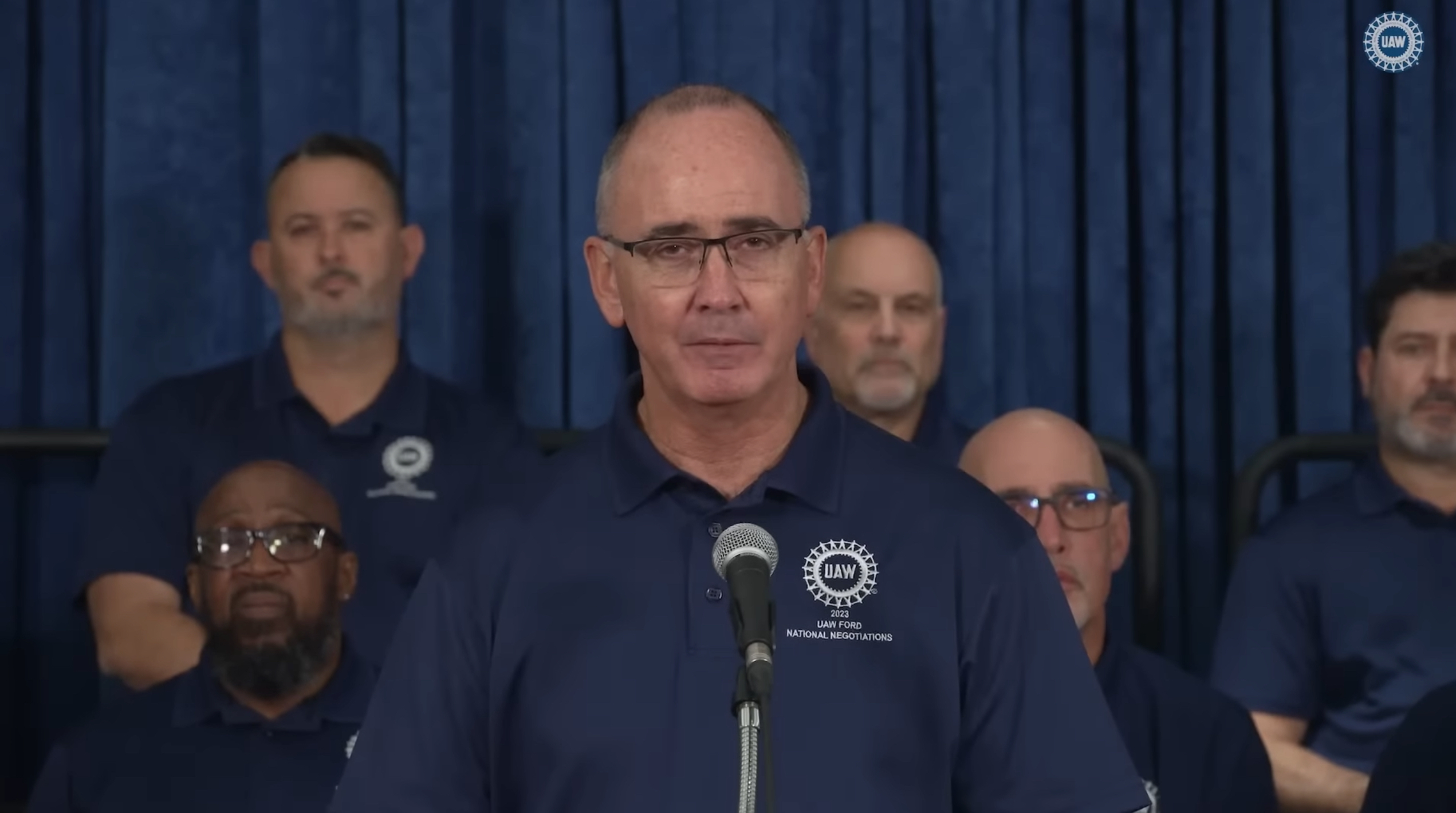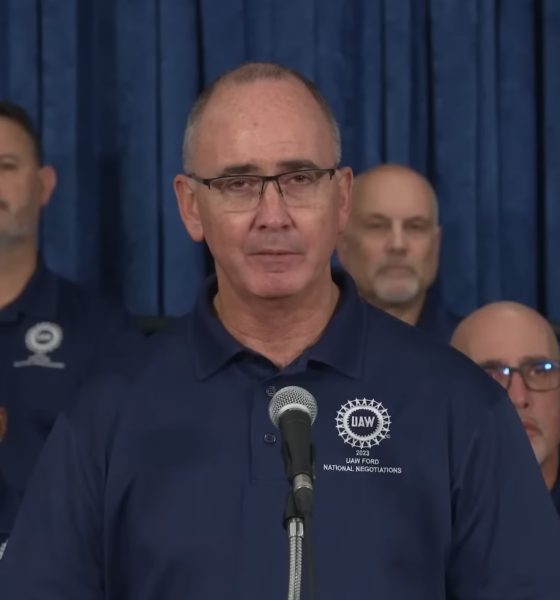The United Auto Workers (UAW) has successfully agreed on tentative contracts with Ford, General Motors (GM) and Stellantis after over six weeks of strikes. However, the union’s president now says that the next round of contract negotiations will include more than just the Big Three, highlighting desires to unionize other automakers like Tesla, Toyota, Volkswagen and others.
UAW President Shawn Fain said on Sunday that the next round of bargaining, set for 2028 when contracts expire again, will include more than just the Big Three, instead including a “Big Five or Big Six,” as detailed in a report from Bloomberg. The statements came after it has been widely speculated that Fain and the UAW might target Tesla next now that the union has come to tentative agreements with Ford, Stellantis and GM.
“One of our biggest goals coming out of this historic contract victory is to organize like we’ve never organized before,” Fain said. “When we return to the bargaining table in 2028, it won’t just be with a Big Three, but with a Big Five or Big Six.”
Earlier this month, Fain also called workers at Tesla, Toyota, Honda and others “UAW members of the future,” highlighting his ambitions to boost membership to include the automakers.
UAW President: Tesla workers are union “members of the future”
Tesla and other automakers, such as Toyota and Volkswagen, have U.S. facilities, though the UAW does not represent workers at those sites. Tesla is not a surprise target for the UAW, being the world’s most valuable automaker and the dominant market leader in electric vehicles (EVs), along with employing tens of thousands of U.S. workers in California, Texas, Nevada and New York.
According to a person familiar with the matter in the Bloomberg report, Tesla’s factory in Fremont, California, has a UAW organizing committee, and its members are actively talking to workers about the benefits of unionization and collective bargaining. The person also said that the UAW has shared its commitment to offering any needed resources for that campaign.
However, past unionization attempts at Tesla have failed, and CEO Elon Musk has been outspoken about his disdain for unions on many occasions. Last year, Musk invited the UAW to hold a vote at its Fremont factory, though it never took place.
A union is just another corporation. Far better for many companies to compete for your skills, so that you have maximum optionality.
— Elon Musk (@elonmusk) May 26, 2022
Labor efforts in other industries show that the landscape has changed since one Tesla worker at the Fremont factory went public with attempts to have the UAW unionize the plant in 2017. At the time, Musk also opposed the attempt, calling the union drive “morally outrageous,” and the campaign faded away after a few years.
“The UAW would love to get into Tesla, but I don’t think they have a chance,” said former Fremont employee Mark Eberley, who worked on a UAW drive at Tesla prior to his departure in 2020.
Others who previously worked at Tesla told Bloomberg that corruption scandals at the UAW and the switch to become a non-union factory when the automaker purchased the plant in 2010 were both viewed as liabilities to a unionization effort. In 2020, former UAW President Dennis Williams pleaded guilty to conspiracy to embezzle union funds after serving as the group’s leader from 2014 to 2018.
Despite the scandal, Fain and the UAW’s success in coming to a tentative agreement with the Big Three comes at a time when several other labor efforts have also taken shape. Additionally, Gallup data shows that the U.S. public has shifted in its views on unions since the last unionization efforts at Tesla. While just over half of Americans reported approving of labor unions in 2016, that number has risen to roughly 67 percent in 2023.
“Any effort to organize Tesla would be a battle royale,” said Seth Harris, President Joe Biden’s former deputy director at the National Economic Council. “The UAW is showing itself to be a militant, well-organized force.”
What are your thoughts? Let me know at zach@teslarati.com, find me on X at @zacharyvisconti, or send your tips to us at tips@teslarati.com.

Elon Musk
Elon Musk’s X will start using a Tesla-like software update strategy
The initiative seems designed to accelerate updates to the social media platform, while maintaining maximum transparency.

Elon Musk’s social media platform X will adopt a Tesla-esque approach to software updates for its algorithm.
The initiative seems designed to accelerate updates to the social media platform, while maintaining maximum transparency.
X’s updates to its updates
As per Musk in a post on X, the social media company will be making a new algorithm to determine what organic and advertising posts are recommended to users. These updates would then be repeated every four weeks.
“We will make the new 𝕏 algorithm, including all code used to determine what organic and advertising posts are recommended to users, open source in 7 days. This will be repeated every 4 weeks, with comprehensive developer notes, to help you understand what changed,” Musk wrote in his post.
The initiative somewhat mirrors Tesla’s over-the-air update model, where vehicle software is regularly refined and pushed to users with detailed release notes. This should allow users to better understand the details of X’s every update and foster a healthy feedback loop for the social media platform.
xAI and X
X, formerly Twitter, has been acquired by Elon Musk’s artificial intelligence startup, xAI last year. Since then, xAI has seen a rapid rise in valuation. Following the company’s the company’s upsized $20 billion Series E funding round, estimates now suggest that xAI is worth tens about $230 to $235 billion. That’s several times larger than Tesla when Elon Musk received his controversial 2018 CEO Performance Award.
As per xAI, the Series E funding round attracted a diverse group of investors, including Valor Equity Partners, Stepstone Group, Fidelity Management & Research Company, Qatar Investment Authority, MGX, and Baron Capital Group, among others. Strategic partners NVIDIA and Cisco Investments also continued support for building the world’s largest GPU clusters.
News
Tesla FSD Supervised wins MotorTrend’s Best Driver Assistance Award
The decision marks a notable reversal for the publication from prior years, with judges citing major real-world improvements that pushed Tesla’s latest FSD software ahead of every competing ADAS system.

Tesla’s Full Self-Driving (Supervised) system has been named the best driver-assistance technology on the market, earning top honors at the 2026 MotorTrend Best Tech Awards.
The decision marks a notable reversal for the publication from prior years, with judges citing major real-world improvements that pushed Tesla’s latest FSD software ahead of every competing ADAS system. And it wasn’t even close.
MotorTrend reverses course
MotorTrend awarded Tesla FSD (Supervised) its 2026 Best Tech Driver Assistance title after extensive testing of the latest v14 software. The publication acknowledged that it had previously criticized earlier versions of FSD for erratic behavior and near-miss incidents, ultimately favoring rivals such as GM’s Super Cruise in earlier evaluations.
According to MotorTrend, the newest iteration of FSD resolved many of those shortcomings. Testers said v14 showed far smoother behavior in complex urban scenarios, including unprotected left turns, traffic circles, emergency vehicles, and dense city streets. While the system still requires constant driver supervision, judges concluded that no other advanced driver-assistance system currently matches its breadth of capability.
Unlike rival systems that rely on combinations of cameras, radar, lidar, and mapped highways, Tesla’s FSD operates using a camera-only approach and is capable of driving on city streets, rural roads, and freeways. MotorTrend stated that pure utility, the ability to handle nearly all road types, ultimately separated FSD from competitors like Ford BlueCruise, GM Super Cruise, and BMW’s Highway Assistant.
High cost and high capability
MotorTrend also addressed FSD’s pricing, which remains significantly higher than rival systems. Tesla currently charges $8,000 for a one-time purchase or $99 per month for a subscription, compared with far lower upfront and subscription costs from other automakers. The publication noted that the premium is justified given FSD’s unmatched scope and continuous software evolution.
Safety remained a central focus of the evaluation. While testers reported collision-free operation over thousands of miles, they noted ongoing concerns around FSD’s configurable driving modes, including options that allow aggressive driving and speeds beyond posted limits. MotorTrend emphasized that, like all Level 2 systems, FSD still depends on a fully attentive human driver at all times.
Despite those caveats, the publication concluded that Tesla’s rapid software progress fundamentally reshaped the competitive landscape. For drivers seeking the most capable hands-on driver-assistance system available today, MotorTrend concluded Tesla FSD (Supervised) now stands alone at the top.
News
Elon Musk’s Grokipedia surges to 5.6M articles, almost 79% of English Wikipedia
The explosive growth marks a major milestone for the AI-powered online encyclopedia, which was launched by Elon Musk’s xAI just months ago.

Elon Musk’s Grokipedia has grown to an impressive 5,615,201 articles as of today, closing in on 79% of the English Wikipedia’s current total of 7,119,376 articles.
The explosive growth marks a major milestone for the AI-powered online encyclopedia, which was launched by Elon Musk’s xAI just months ago. Needless to say, it would only be a matter of time before Grokipedia exceeds English Wikipedia in sheer volume.
Grokipedia’s rapid growth
xAI’s vision for Grokipedia emphasizes neutrality, while Grok’s reasoning capabilities allow for fast drafting and fact-checking. When Elon Musk announced the initiative in late September 2025, he noted that Grokipedia would be an improvement to Wikipedia because it would be designed to avoid bias.
At the time, Musk noted that Grokipedia “is a necessary step towards the xAI goal of understanding the Universe.”
Grokipedia was launched in late October, and while xAI was careful to list it only as Version 0.1 at the time, the online encyclopedia immediately earned praise. Wikipedia co-founder Larry Sanger highlighted the project’s innovative approach, noting how it leverages AI to fill knowledge gaps and enable rapid updates. Netizens also observed how Grokipedia tends to present articles in a more objective manner compared to Wikipedia, which is edited by humans.
Elon Musk’s ambitious plans
With 5,615,201 total articles, Grokipedia has now grown to almost 79% of English Wikipedia’s article base. This is incredibly quick, though Grokipedia remains text-only for now. xAI, for its part, has now updated the online encyclopedia’s iteration to v0.2.
Elon Musk has shared bold ideas for Grokipedia, including sending a record of the entire knowledge base to space as part of xAI’s mission to preserve and expand human understanding. At some point, Musk stated that Grokipedia will be renamed to Encyclopedia Galactica, and it will be sent to the cosmos.
“When Grokipedia is good enough (long way to go), we will change the name to Encyclopedia Galactica. It will be an open source distillation of all knowledge, including audio, images and video. Join xAI to help build the sci-fi version of the Library of Alexandria!” Musk wrote, adding in a later post that “Copies will be etched in stone and sent to the Moon, Mars and beyond. This time, it will not be lost.”










